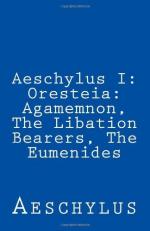|
This section contains 1,525 words (approx. 6 pages at 300 words per page) |

|
Fighting Injustice in Ancient Greece
Summary: The different views of using violence as justice in ancient Greece as portrayed in the works of Aeschylus and Homer. Homer's works condone violence as a form of justice, while Aeschylus attempts to show the harm of counteracting violence with more violence.
The use of violence as the answer to injustice is addressed in both the Odyssey and the Agamemnon. Violent revenge as a form of punishment was commonplace in Greek culture, but its effectiveness varies between these works. Odysseus' violent retribution against the suitors in his house proved to be successful in ending the injustice that was created by the suitors. On the other hand, the violence used by Clytaemnestra against Agamemnon and Cassandra in retaliation for Agamemnon's killing of their daughter just caused more violence, as Orestes avenged Agamemnon's death by killing Clytaemnestra and Aegisthus. The two different views of violence as the answer to injustice given by Homer and Aeschylus reveal a contradiction in how appropriate violence is in resolving injustice. While Homer's story depicts a situation in which all is well after Odysseus uses violence to combat the injustice taking place in his house, Aeschylus shows...
|
This section contains 1,525 words (approx. 6 pages at 300 words per page) |

|


